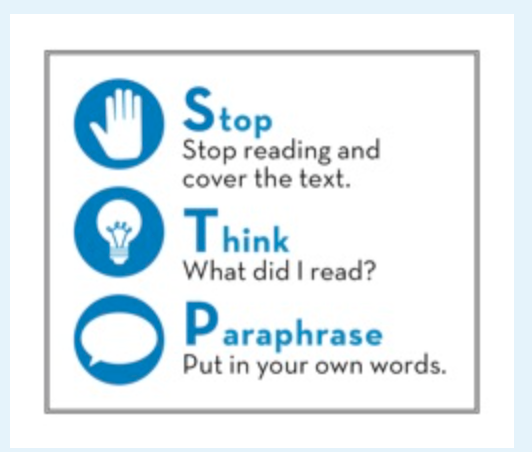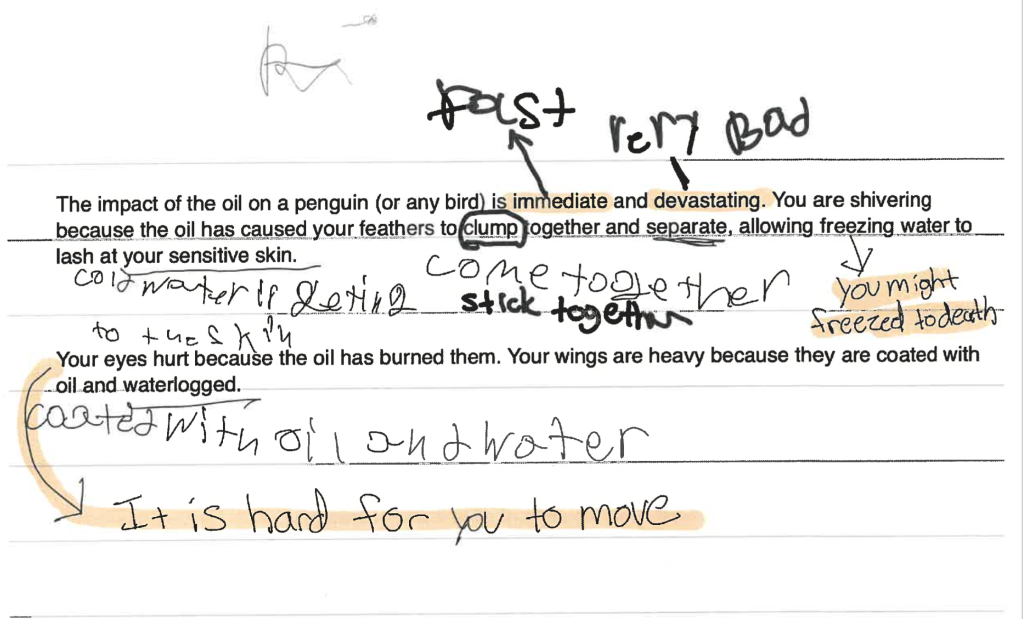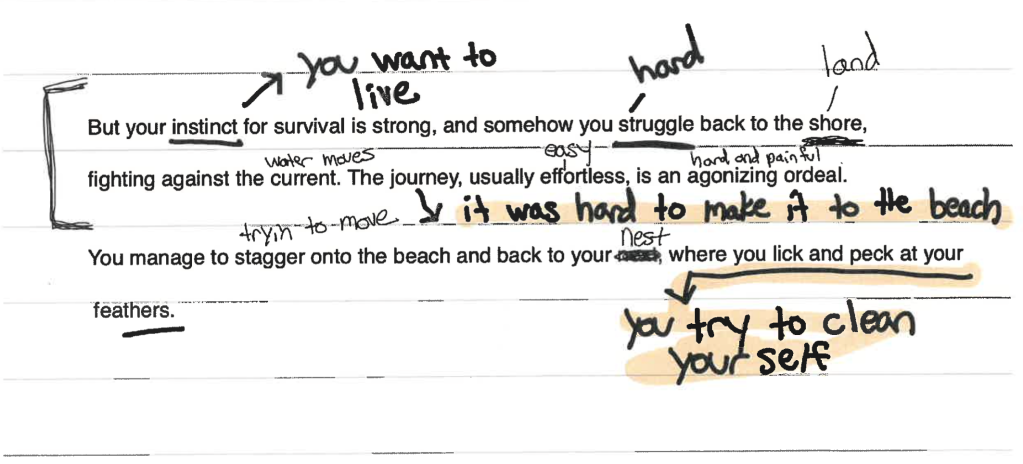I have been working with a group of 5th graders on using STP (Stop, Think, & Paraphrase) in combination with Sunday Cummins Explode & Explain strategy. Here is another article about it. Explode & Explain. A version of STP is really embedded into Explode & Explain when you think about it.
A common way I see STP being used is shown below.

I alter this method. I do not ask students to cover up the text. I think it is essential for students to see the words and their notes when talking them, to help them paraphrase. Also, students may be able to pull out and use keywords/phrases to intermix within their paraphrasing, but still not truly understand the writer’s intended meaning. I want students to be able to use STP to help them stop and focus on unknown vocabulary that is helpful for readers to figure out what the writer wants them to understand. We worked on figuring out the meaning of unfamiliar words, as we explode and explain. That is why STP alone is not enough for a lot of students.
Using Explode & Explain prepares students for the next step of paraphrasing. I want students to look at the text and to use their annotations and notes to refer back to. This is important for ELL students or any student who needs support with vocabulary. Students are very hesitant to express out loud what they are thinking a word might mean. However, when I ask them to slow down and explode and explain certain parts of the text it starts to happen naturally. Faces light up, I hear an “Oh, I get it”.
Another important component of STP is helping students understand that they need to self-monitoring for meaning as they read. With the striving readers I work with as a reading specialist, I have to really work hard to help students understand how to read with an intent to grow their intellect, academically and emotionally. They often want to read just to finish and want the act of finishing to be the accomplishment.
How often should students “stop, think & paraphrase”?” How often depends on the individual student/group, and the text. I do not always think set stopping point need to be required. Students have to learn to do the self-monitoring work for themselves. Self-monitoring brings authenticity to the strategy and helps the students gain some agency when they figure out when and where to pause and apply it when reading independently. They are not just following steps mindlessly.
For my lessons with this guided reading group, I chose the places we would stop and use a combination of the two strategies. This decision was more about saving time and limiting the cognitive load for this group, so we could focus on learning the strategies.
I started this journey by explaining and reiterating how these strategies can be done in our heads as we read, or in a written format, digitally, or on paper. I want them to know that my hope is for them to internalize the strategies and to be able to use them in their head after they become comfortable enough with them. I also try to keep in mind that students may be able to use these strategies in their heads with some texts and not with others. The content of the text and the student’s knowledge will affect this. I am the same way as an avid reader.
I am also using these strategies to help them carry on a conversation about their reading and apply what they are learning to other situations. We discuss using the notes we create when Exploding & Explaining to help us then paraphrase the information. I model paraphrasing using my notes and then ask them to do the same with a partner. I stress speaking in complete sentences that can easily be transferred into writing. I emphasize with older students that what and how we speak and write affects how others see us. We want what we say and write to make sense not only to ourselves but to others as well. We do a lot of oral rehearsing because of this and I provide sentence stems when I feel the group/student needs it.
Below is a sample of one student’s work that I gave some support with figuring out the meaning of some words. I took a few sentences from the article The Amazing Penguin Rescue by Lauran Tarshis that we had been reading, and used a note-taking app to project it. We worked on the first sets of sentences together. Students worked on the finals sentences on their own with me providing support when confering with them. They will use the notes to help them discuss and write about the article.
For this article I chose to have the students write about the challenges faced by the penguin and the humans trying to save them. When rehearsing for the writing I had planned to use a sentence frame like this one:
____________ was challenging for the humans/penguins because ______________
These students started planning without the need for it, however.



Hope this provides you with something to think about and reflect on.
Troy
You must be logged in to post a comment.